A Multi-Objective Model in Combination with Geographic Information System Tools for the Location of Urban Green Areas
Abstract
1. Introduction
- Planet Pillar: This pillar captures key environmental factors, including energy consumption, air pollution, the availability of green spaces and waste management.
- People Pillar: This measures various aspects of quality of life, such as health, access to education, crime rates, economic inequality, access to public transportation and the availability of Wi-Fi.
- Profit Pillar: This pillar assesses the business environment and economic performance, including the ease of doing business, business network development and employment opportunities.
- Progress Pillar: This measures sustainable progress through key indicators derived from the Planet, People and Profit pillars, which are monitored over a 10-year span.
2. Background
2.1. Definition of the Elements of Urban Green Areas
- Large parks and gardens serve as major green spaces accessible to all residents, extending their significance beyond individual neighborhoods. Due to their size and complexity, these green areas provide a wide array of ecosystem services to the city.
- Neighborhood parks, ranging in size from 1000 to 15,000 (data for Valencia), are designed primarily for use by local residents. Unlike other smaller garden areas, neighborhood parks are distinguished by their ability to provide specific amenities and services. These often include children’s play areas, sports fields and spaces reflecting historical or cultural significance.
- Green areas and gardens with public facilities that are not permanently accessible, such as university or school green areas, cultural facilities or cemeteries.
- Landscaped boulevards, promenades and avenues are key green corridors that connect roads of municipal importance. These spaces are vital for integrating the green infrastructure across a city, enhancing connectivity between various green areas.
2.2. Definition of Coverage
2.3. Determining Location Criteria
- Coverage: Population distribution in a territory is not usually homogeneous; some areas are more densely populated than others. Locating a green space in an area with high population density ensures that more people can access it, thus achieving greater coverage.
- Equity: Economic circumstances, employment or personal preferences may lead individuals to choose less densely populated areas as their residences. These residents should also have access to green spaces near their homes.
3. Proposed Methodology
- Analyze the existing green coverage.
- –
- Define the work area and spatial unit.
- –
- Define the elements of urban green areas.
- –
- Determine the existing green areas in the city.
- –
- Determine the coverage.
- Identify the area without green coverage.
- Determine the inputs for the mathematical model.
- –
- Obtain the possible locations for the green areas.
- –
- Determine the location criteria.
4. Mathematical Model and Solution Method
4.1. Mathematical Model
4.2. Solution Method
5. Computational Experiments
5.1. Analysis of Existing Green Coverage
- Definition of the work area and the spatial unit.The city of Valencia (Figure 3a) covers an area of 13,465 hectares and has a total population of 797,665 people, as of 2024, distributed across 19 neighborhoods. However, this study focuses only on the central area of Valencia, comprising 17 neighborhoods (Figure 3b). The excluded neighborhoods are of a mixed urban and rural nature. For greater precision, we selected only the populated areas using the land use map [42], including continuous urban network, discontinuous urban network, industrial, sports and commercial areas.
- Determination of the elements of urban green areas.This work focuses on the first two groups described in Section 2.1: large parks and gardens and neighborhood parks. Green areas and gardens with public facilities are not permanently accessible, and their regular use is quite restricted. Similarly, landscaped walkways or avenues serve as transit areas rather than spaces for recreational use.
- Determination of existing green areas in the city.The city of Valencia is committed to the 2030 Agenda. The Valencia City Council has launched various projects to honor this commitment, including Missions Valencia 2030 [43], which aims to make Valencia a climate-neutral city by 2030. Additionally, an important initiative called the Green Plan [7] is being developed. This strategic document aims to enhance the management of the municipal green infrastructure.For this work, the map of urban green areas in Valencia has been generated, based on the data provided by the Geoportal [44]. Figure 4 illustrates the location of Valencia’s existing urban green areas. Notably, a green strip, known as the Turia Garden (formerly a riverbed), traverses the entire city and is divided into several sections due to its size. This study focuses on 22 large parks and gardens as well as 31 neighborhood parks, with these green spaces covering a total area of 2,664,360 .
- Determination of existing green coverage.An important aspect to consider when discussing spatial objects, such as parks, is their geometry. While isochrone calculations typically start with a point of origin, parks are better represented as polygons rather than single points. To address this, the polygon must be converted into a point for isochrone calculations. In this analysis, we use the centroid of the polygon, effectively the center of the green area, as this is a common practice in the scientific community [23,35].To determine the current coverage, the parameters for calculating isochrones must be established. It is assumed that residents travel on foot. Due to the smaller size of neighborhood green areas, a 5-min isochrone—a commonly accepted time—is used. For large parks and gardens, the isochrone time is extended to 10 min, as these parks typically offer a greater number of recreational amenities, therefore encouraging people to travel further. The result is shown in Figure 5a. Joining all the isochrones gives the current green coverage, i.e., the areas that have access to a green space within a maximum of 10 min’ walk (see Figure 5b).
5.2. Obtaining the Areas Without Green Coverage
5.3. Determination of the Inputs for the Mathematical Model
- Obtaining the possible locations for green areas.To identify potential locations for green spaces within uncovered areas, QGIS provides several useful algorithms. Points can be evenly or variably generated for each neighborhood, either randomly or deterministically. For this analysis, 20 points were randomly generated, guaranteeing at least one location per neighborhood. Three neighborhoods with the most significant uncovered areas received two locations each. Figure 7 shows the 20 possible locations for the green zones.
- Description of the location criteria.
- –
- Coverage.For each of the 20 proposed points, a 5 min walk isochrone is calculated to determine the marginal covered population (), representing individuals who would gain access to green space. This population occurs where the isochrone overlaps with the orange, uncovered area, excluding overlaps with already covered green areas. Using geoprocessing algorithms and the raster layer (pixel image) of population density in the Global Human Settlement Layer [45], we calculate marginal coverage for all proposed locations. This layer was chosen because its population estimate showed a lower deviation from the resident population data for 266 municipalities in the Province of Valencia, as provided by the National Institute of Statistics [46]. In Figure 7a, the size of the points has been represented by the marginal population. The best locations are those that provide the greatest marginal coverage. While selecting these locations may seem straightforward, even with an extensive set of 100, the process becomes intricate when adhering to constraints. For instance, proximity restrictions prevent choosing nearby points, such as points 6 and 13 in Figure 7a. The complexity of selection further escalates with the introduction of additional necessary restrictions.
- –
- Equity.This criterion favors neighborhoods farther from existing green spaces, promoting equitable access. Figure 7b illustrates the Euclidean distances from each of the 20 points to the nearest green space. Variations in blue line lengths highlight these differences. Good solutions increase the minimum distance to existing green spaces. Although Euclidean distances serve for visual purposes here, true optimization relies on real distances obtained using the QGIS Openrouteservice plugin.
5.4. Application of the Mathematical Model
5.5. Visualization, Analysis and Evaluation of the Solution
6. Discussion and Conclusions
Author Contributions
Funding
Data Availability Statement
Acknowledgments
Conflicts of Interest
References
- UN. 2024. Available online: https://www.un.org/sustainabledevelopment/cities/ (accessed on 1 May 2025).
- Statista. 2024. Available online: https://www.statista.com/statistics/276629/global-co2-emissions/ (accessed on 1 May 2025).
- Arcadis. The Arcadis Sustainable Cities Index 2024. Technical Report. 2024. Available online: https://www.arcadis.com/ (accessed on 1 May 2025).
- Jing, L.; Liang, Y. The impact of tree clusters on air circulation and pollutant diffusion-urban micro scale environmental simulation based on ENVI-met. IOP Conf. Ser. Earth Environ. Sci. 2021, 657, 012008. [Google Scholar] [CrossRef]
- Santiago, J.L.; Martilli, A.; Martin, F. On dry deposition modelling of atmospheric pollutants on vegetation at the microscale: Application to the impact of street vegetation on air quality. Bound.-Layer Meteorol. 2017, 162, 451–474. [Google Scholar] [CrossRef]
- Alonso, R.; Vivanco, M.G.; González-Fernández, I.; Bermejo, V.; Palomino, I.; Garrido, J.L.; Elvira, S.; Salvador, P.; Artíñano, B. Modelling the influence of peri-urban trees in the air quality of Madrid region (Spain). Environ. Pollut. 2011, 159, 2138–2147. [Google Scholar] [CrossRef]
- Ajuntament de València. Plan Verde y de la Biodiversidad de València. 2021. Available online: https://plaverdvalencia.com/es/documentacion/ (accessed on 1 July 2024).
- Iberdrola. 2022. Available online: https://www.iberdrola.com/sustainability/sustainable-cities (accessed on 1 October 2024).
- Khomenko, S.; Cirach, M.; Pereira-Barboza, E.; Mueller, N.; Barrera-Gómez, J.; Rojas-Rueda, D.; de Hoogh, K.; Hoek, G.; Nieuwenhuijsen, M. Premature mortality due to air pollution in European cities: A health impact assessment. Lancet Planet. Health 2021, 5, e121–e134. [Google Scholar] [CrossRef]
- Labib, S.; Lindley, S.; Huck, J.J. Estimating multiple greenspace exposure types and their associations with neighbourhood premature mortality: A socioecological study. Sci. Total Environ. 2021, 789, 147919. [Google Scholar] [CrossRef]
- Gascon, M.; Sánchez-Benavides, G.; Dadvand, P.; Martínez, D.; Gramunt, N.; Gotsens, X.; Cirach, M.; Vert, C.; Molinuevo, J.L.; Crous-Bou, M.; et al. Long-term exposure to residential green and blue spaces and anxiety and depression in adults: A cross-sectional study. Environ. Res. 2018, 162, 231–239. [Google Scholar] [CrossRef]
- Vanaken, G.J.; Danckaerts, M. Impact of green space exposure on children’s and adolescents’ mental health: A systematic review. Int. J. Environ. Res. Public Health 2018, 15, 2668. [Google Scholar] [CrossRef]
- White, M.P.; Elliott, L.R.; Grellier, J.; Economou, T.; Bell, S.; Bratman, G.N.; Cirach, M.; Gascon, M.; Lima, M.L.; Lõhmus, M.; et al. Associations between green/blue spaces and mental health across 18 countries. Sci. Rep. 2021, 11, 8903. [Google Scholar] [CrossRef] [PubMed]
- Yañez, D.V.; Barboza, E.P.; Cirach, M.; Daher, C.; Nieuwenhuijsen, M.; Mueller, N. An urban green space intervention with benefits for mental health: A health impact assessment of the Barcelona “Eixos Verds” Plan. Environ. Int. 2023, 174, 107880. [Google Scholar] [CrossRef]
- Krellenberg, K.; Welz, J.; Reyes-Päcke, S. Urban green areas and their potential for social interaction—A case study of a socio-economically mixed neighbourhood in Santiago de Chile. Habitat Int. 2014, 44, 11–21. [Google Scholar] [CrossRef]
- Wan, C.; Shen, G.Q.; Choi, S. Underlying relationships between public urban green spaces and social cohesion: A systematic literature review. City Cult. Soc. 2021, 24, 100383. [Google Scholar] [CrossRef]
- WHO. Urban Green Spaces and Health. Technical Report. World Health Organization. Regional Office for Europe. 2016. Available online: https://www.who.int/europe/publications/i/item/WHO-EURO-2016-3352-43111-60341 (accessed on 1 October 2024).
- Lin, S.H.; Zhao, X.; Wu, J.; Liang, F.; Li, J.H.; Lai, R.J.; Hsieh, J.C.; Tzeng, G.H. An evaluation framework for developing green infrastructure by using a new hybrid multiple attribute decision-making model for promoting environmental sustainability. Socio-Econ. Plan. Sci. 2021, 75, 100909. [Google Scholar] [CrossRef]
- Wolch, J.R.; Byrne, J.; Newell, J.P. Urban green space, public health, and environmental justice: The challenge of making cities ‘just green enough’. Landsc. Urban Plan. 2014, 125, 234–244. [Google Scholar] [CrossRef]
- Ekkel, E.D.; de Vries, S. Nearby green space and human health: Evaluating accessibility metrics. Landsc. Urban Plan. 2017, 157, 214–220. [Google Scholar] [CrossRef]
- Laan, C.M.; Piersma, N. Accessibility of green areas for local residents. Environ. Sustain. Indic. 2021, 10, 100114. [Google Scholar] [CrossRef]
- Hsu, Y.Y.; Hawken, S.; Sepasgozar, S.; Lin, Z.H. Beyond the backyard: GIS analysis of public green space accessibility in Australian metropolitan areas. Sustainability 2022, 14, 4694. [Google Scholar] [CrossRef]
- Pinto, L.V.; Ferreira, C.S.S.; Inácio, M.; Pereira, P. Urban green spaces accessibility in two European cities: Vilnius (Lithuania) and Coimbra (Portugal). Geogr. Sustain. 2022, 3, 74–84. [Google Scholar] [CrossRef]
- Van Herzele, A.; Wiedemann, T. A monitoring tool for the provision of accessible and attractive urban green spaces. Landsc. Urban Plan. 2003, 63, 109–126. [Google Scholar] [CrossRef]
- Newell, J.P.; Seymour, M.; Yee, T.; Renteria, J.; Longcore, T.; Wolch, J.R.; Shishkovsky, A. Green Alley Programs: Planning for a sustainable urban infrastructure? Cities 2013, 31, 144–155. [Google Scholar] [CrossRef]
- Huang, C.; Huang, P.; Wang, X.; Zhou, Z. Assessment and optimization of green space for urban transformation in resources-based city—A case study of Lengshuijiang city, China. Urban For. Urban Green. 2018, 30, 295–306. [Google Scholar] [CrossRef]
- Plaza, P. València Dispone de 178.000 Metros Cuadrados de Suelo Residencial para Desarrollar Vivienda. 2022. Available online: https://valenciaplaza.com/valencia-dispone-de-178000-metros-cuadrados-de-suelo-residencial-para-desarrollar-vivienda (accessed on 1 October 2024).
- Green, O.O.; Garmestani, A.S.; Albro, S.; Ban, N.C.; Berland, A.; Burkman, C.E.; Gardiner, M.M.; Gunderson, L.; Hopton, M.E.; Schoon, M.L.; et al. Adaptive governance to promote ecosystem services in urban green spaces. Urban Ecosyst. 2016, 19, 77–93. [Google Scholar] [CrossRef]
- Nyelele, C.; Kroll, C.N. A multi-objective decision support framework to prioritize tree planting locations in urban areas. Landsc. Urban Plan. 2021, 214, 104172. [Google Scholar] [CrossRef]
- Wicki, S.; Schwaab, J.; Perhac, J.; Grêt-Regamey, A. Participatory multi-objective optimization for planning dense and green cities. J. Environ. Plan. Manag. 2021, 64, 2532–2551. [Google Scholar] [CrossRef]
- Liu, J.; Zhang, D.; Wang, J.; Ding, X.; Mei, C. Multi-Objective Optimization and Decision-Making of Green Infrastructure Layout Considering Carbon Emission. Energy Proc. 2021, 23, 530. [Google Scholar]
- Zucca, A.; Sharifi, A.M.; Fabbri, A.G. Application of spatial multi-criteria analysis to site selection for a local park: A case study in the Bergamo Province, Italy. J. Environ. Manag. 2008, 88, 752–769. [Google Scholar] [CrossRef]
- Neema, M.N.; Ohgai, A. Multi-objective location modeling of urban parks and open spaces: Continuous optimization. Comput. Environ. Urban Syst. 2010, 34, 359–376. [Google Scholar] [CrossRef]
- Vallejo, M.; Rieser, V.; Corne, D.W. Genetic algorithm evaluation of green search allocation policies in multilevel complex urban scenarios. J. Comput. Sci. 2015, 9, 57–63. [Google Scholar] [CrossRef]
- Sefair, J.A.; Molano, A.; Medaglia, A.L.; Sarmiento, O.L. Locating neighborhood parks with a lexicographic multiobjective optimization method. In Community-Based Operations Research; Springer: New York, NY, USA, 2012; pp. 143–171. [Google Scholar]
- Li, X.; Li, X.; Ma, X. Spatial optimization for urban green space (UGS) planning support using a heuristic approach. Appl. Geogr. 2022, 138, 102622. [Google Scholar] [CrossRef]
- BOE. Orden PCM/735/2021, de 9 de julio, por la que se aprueba la Estrategia Nacional de Infraestructura Verde y de la Conectividad y Restauración Ecológicas. Minist. Pres. Relac. Cortes Mem. Democrática 2021, 166, 83217–83470. [Google Scholar]
- Pengelly Consultants. ‘Nature Nearby’ Accessible Natural Greenspace Guidance; Natural England: York, UK, 2010; Available online: http://www.ukmaburbanforum.co.uk/docunents/other/nature_nearby.pdf (accessed on 1 October 2024).
- Eiselt, H.A.; Sandblom, C.L. Operations Research: A Model-Based Approach; Springer Nature: Cham, Switzerland, 2022. [Google Scholar]
- QGIS. Available online: https://www.qgis.org/es/site/ (accessed on 1 February 2025).
- Openrouteservice. Available online: https://openrouteservice.org/ (accessed on 1 February 2025).
- L’Institut Cartogràfic Valencià. Corine Land Cover 2018 a la Comunitat Valenciana. Available online: https://geocataleg.gva.es/#/?lang=spa (accessed on 1 February 2025).
- Ajuntament de València. Missions València 2030. Available online: https://www.missionsvalencia.eu/?lang=es (accessed on 1 June 2024).
- Ajuntament de València. GEOPORTAL. Available online: https://geoportal.valencia.es/apps/GeoportalHome/es/inicio/ (accessed on 1 March 2025).
- UE. GHSL—Global Human Settlement Layer. Available online: https://ghsl.jrc.ec.europa.eu/download.php?ds= (accessed on 1 July 2024).
- INE. Available online: https://www.ine.es/ (accessed on 1 July 2024).
- Zhang, W.; Nian, P.; Lyu, G. A multimodal approach to assessing accessibility of a high-speed railway station. J. Transp. Geogr. 2016, 54, 91–101. [Google Scholar] [CrossRef]
- Yang, Y.; Li, J.; Huang, Q.; Xia, J.; Li, J.; Liu, D.; Tan, Q. Performance assessment of sponge city infrastructure on stormwater outflows using isochrone and SWMM models. J. Hydrol. 2021, 597, 126151. [Google Scholar] [CrossRef]
- Karpova, Y.; Villa, F.; Vallada, E.; Vecina, M.Á. Heuristic algorithms based on the isochron analysis for dynamic relocation of medical emergency vehicles. Expert Syst. Appl. 2023, 212, 118773. [Google Scholar] [CrossRef]

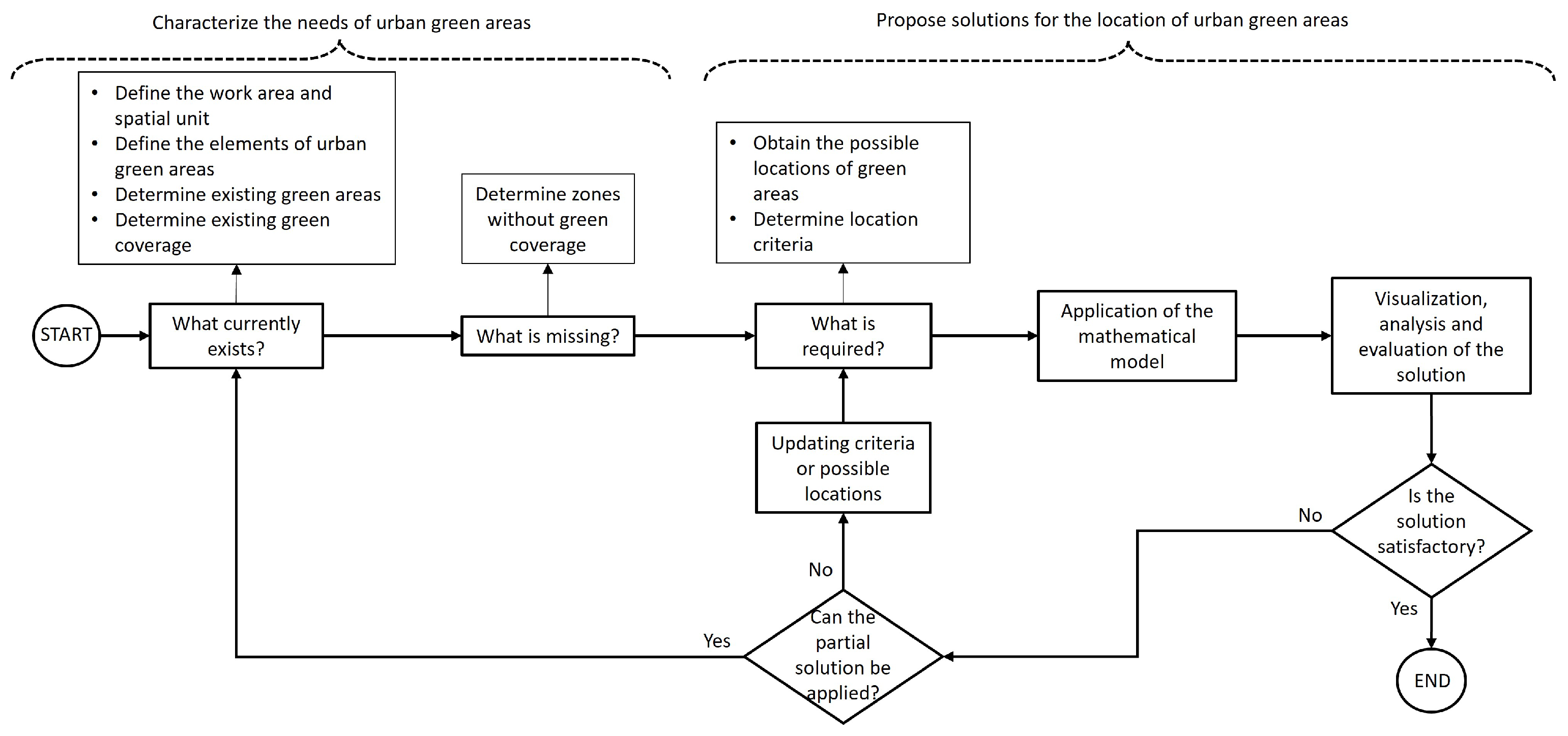
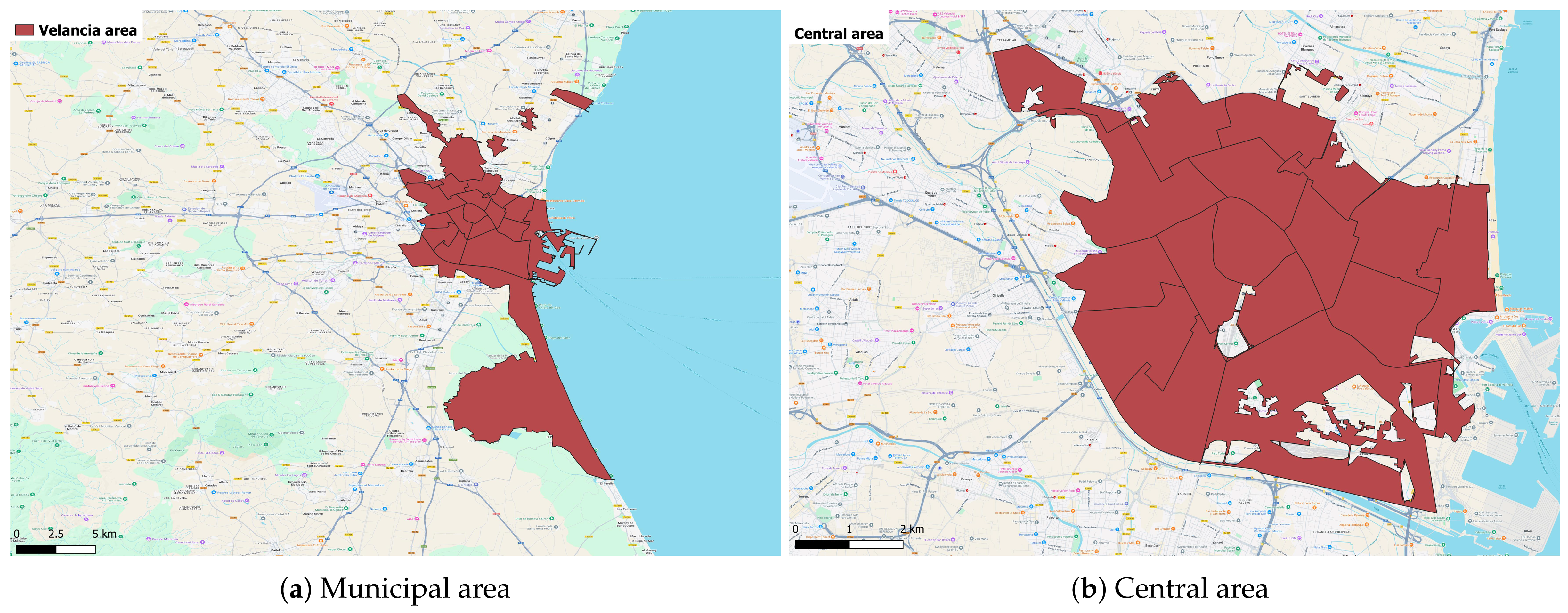
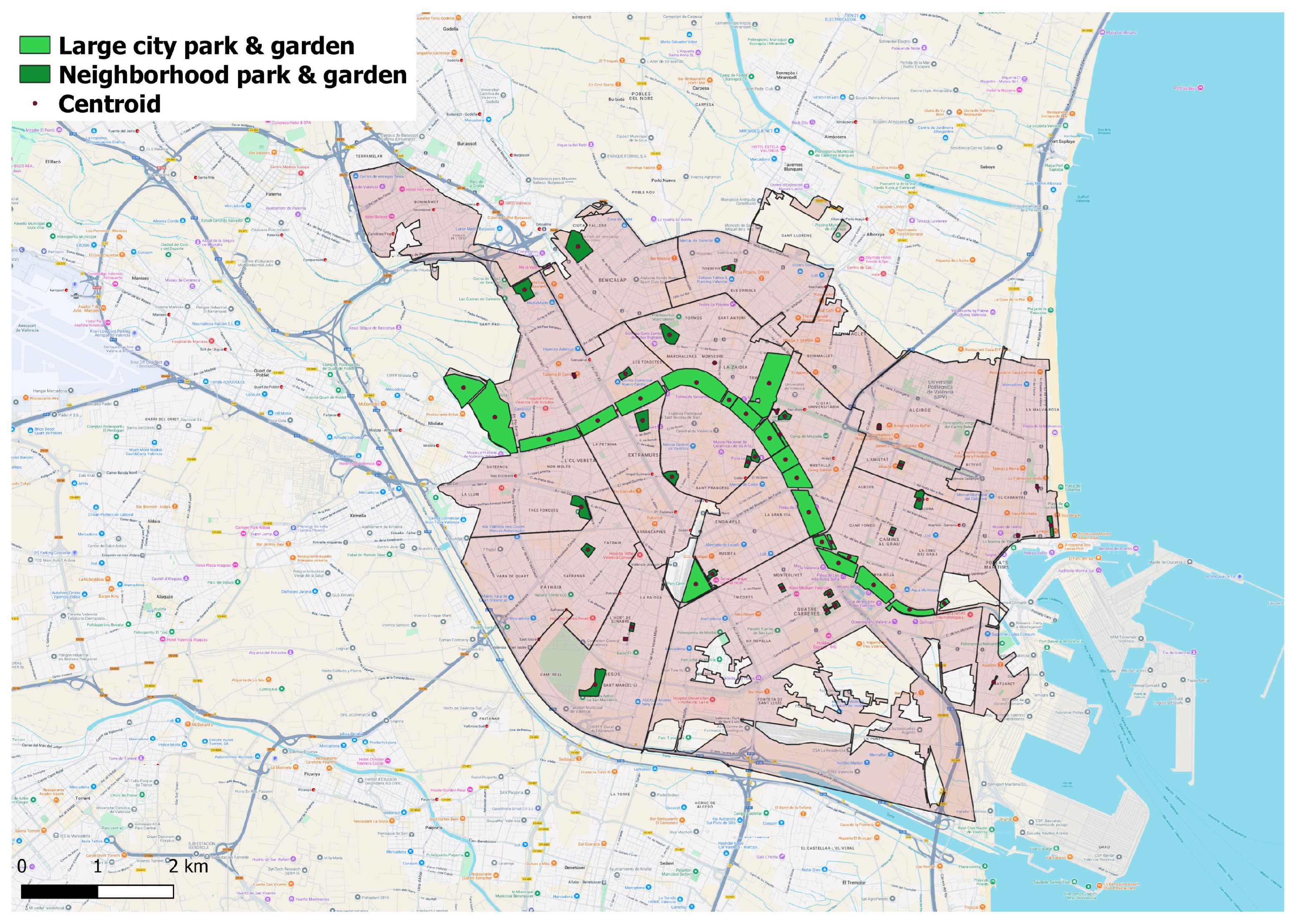
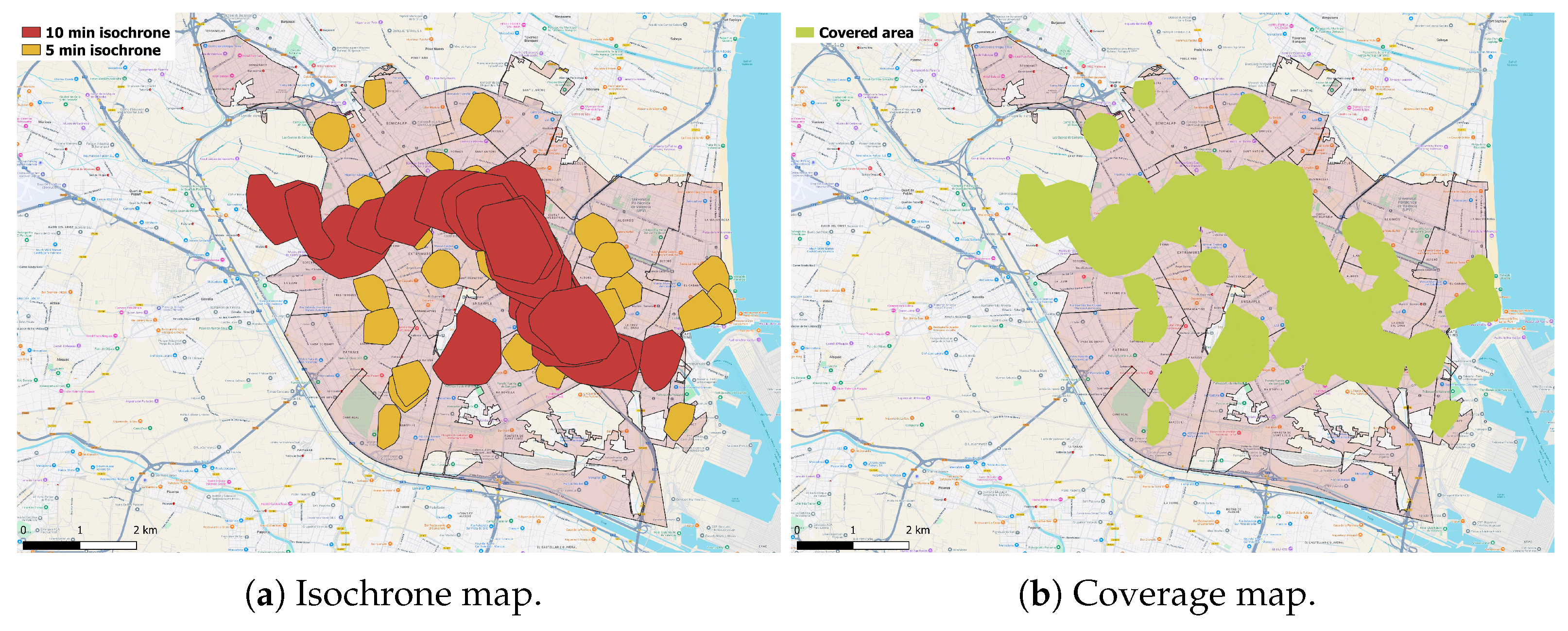
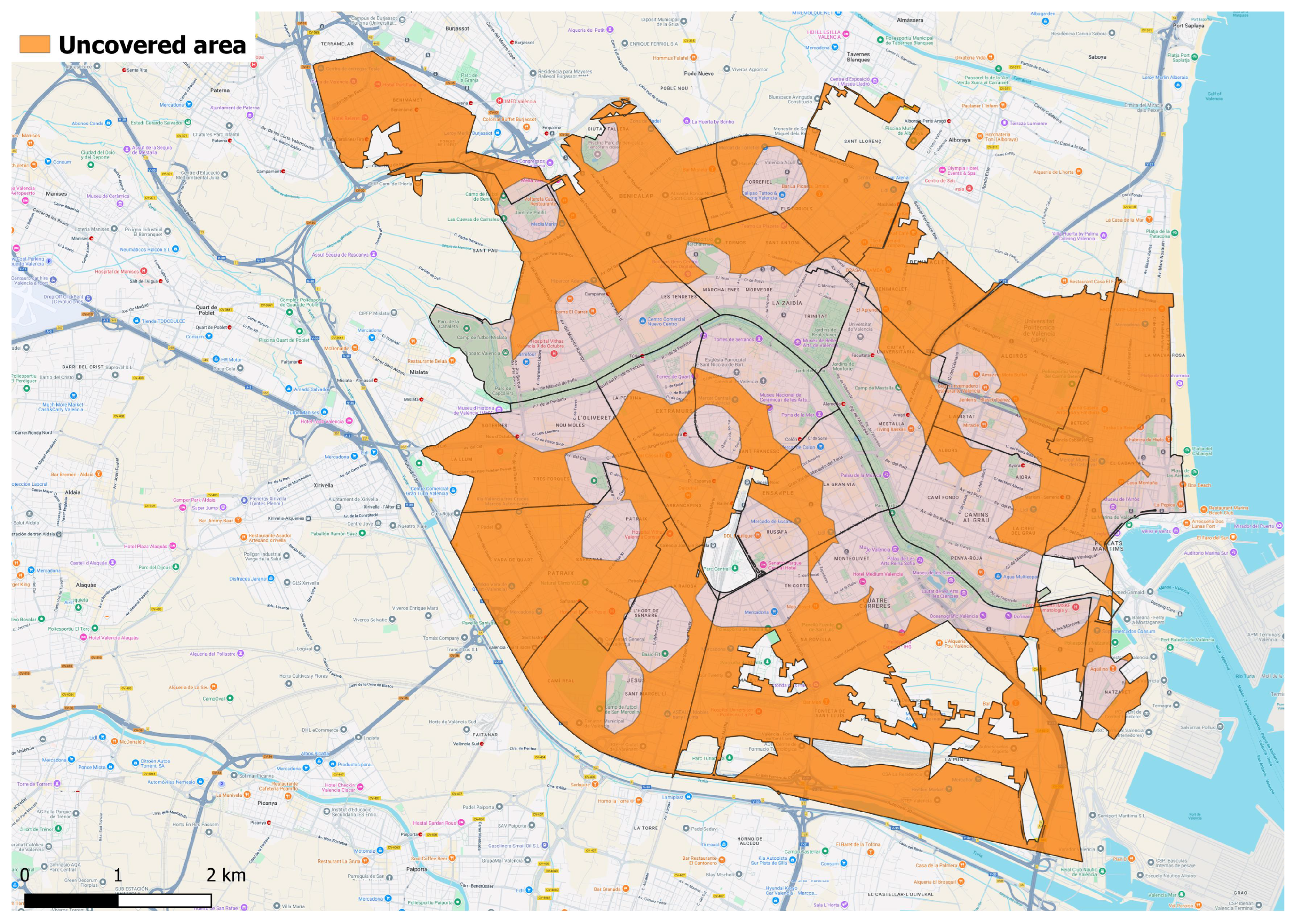


| Parameters and Sets | |
|---|---|
| M | Set of all possible locations for a green zone |
| B | Set of neighborhoods |
| P | Maximum number of green zones to locate |
| Covered population (population that has access to the green zone located in in a given time t) | |
| Distance (in meters) between each pair of possible locations | |
| Minimum distance (in meters) allowed between two possible locations | |
| Minimum distance (in meters) between the possible location i and an existing green zone | |
| Percentage of the maximum deterioration of the value of the objective function allowed | |
| M | Set of all possible locations for a green zone | 20 |
| B | Set of neighborhoods | 17 |
| P | Maximum number of green zones to locate | 5 |
| Minimum distance (in meters) allowed between two possible locations | 1000 m | |
| Percentage of the maximum deterioration of the value of the objective function allowed | 5% |
| Max. Coverage | Max. Equity | |
|---|---|---|
| Max. coverage | 24,526 | 7283 |
| Max. equity | 20,350 | 9593 |
| Max. Coverage | Max. Equity | Prior. Coverage | Prior. Equity | |
|---|---|---|---|---|
| Covered population | 24,526 | 20,350 | 23,674 | 21,624 |
| Distance (in meters) | 7283 | 9593 | 7480 | 9246 |
Disclaimer/Publisher’s Note: The statements, opinions and data contained in all publications are solely those of the individual author(s) and contributor(s) and not of MDPI and/or the editor(s). MDPI and/or the editor(s) disclaim responsibility for any injury to people or property resulting from any ideas, methods, instructions or products referred to in the content. |
© 2025 by the authors. Licensee MDPI, Basel, Switzerland. This article is an open access article distributed under the terms and conditions of the Creative Commons Attribution (CC BY) license (https://creativecommons.org/licenses/by/4.0/).
Share and Cite
Karpova, Y.; Villa, F.; Vallada, E.; Pan, W.A. A Multi-Objective Model in Combination with Geographic Information System Tools for the Location of Urban Green Areas. Mathematics 2025, 13, 2006. https://doi.org/10.3390/math13122006
Karpova Y, Villa F, Vallada E, Pan WA. A Multi-Objective Model in Combination with Geographic Information System Tools for the Location of Urban Green Areas. Mathematics. 2025; 13(12):2006. https://doi.org/10.3390/math13122006
Chicago/Turabian StyleKarpova, Yulia, Fulgencia Villa, Eva Vallada, and Wanzhen Ana Pan. 2025. "A Multi-Objective Model in Combination with Geographic Information System Tools for the Location of Urban Green Areas" Mathematics 13, no. 12: 2006. https://doi.org/10.3390/math13122006
APA StyleKarpova, Y., Villa, F., Vallada, E., & Pan, W. A. (2025). A Multi-Objective Model in Combination with Geographic Information System Tools for the Location of Urban Green Areas. Mathematics, 13(12), 2006. https://doi.org/10.3390/math13122006






